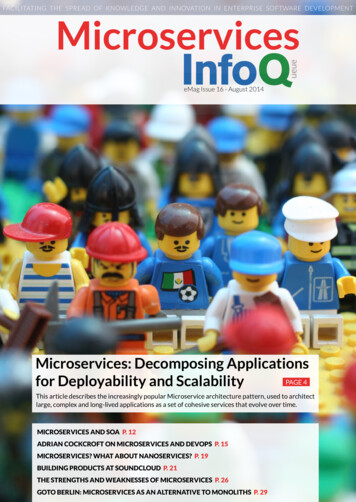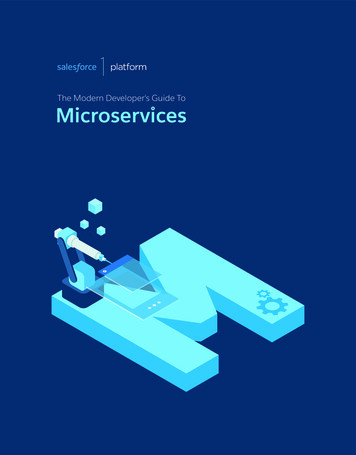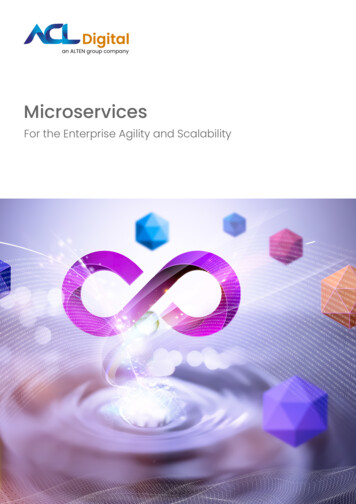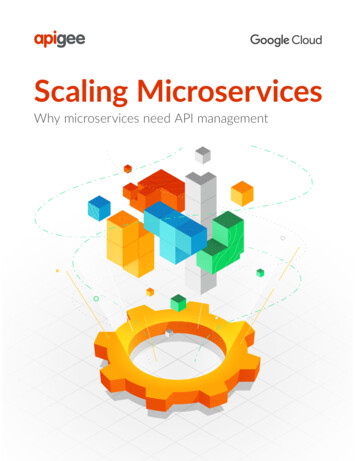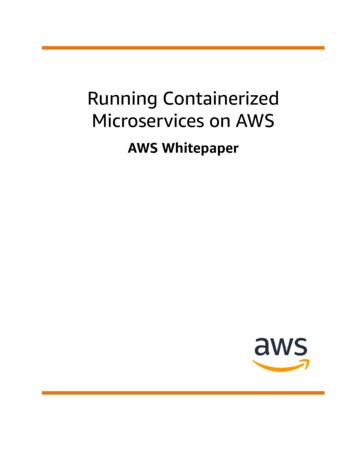
Transcription
ACHIEVING ENTERPRISEAGILITY WITHMICROSERVICES AND APIMANAGEMENTJUNE 2016BY MANFRED BORTENSCHLAGERA microservices architecture and its underlying APIsallow organizations to build and maintain more agileand flexible IT systems. Microservices support moremodular, autonomous systems, and well-managed APIsform the foundation of this architectural framework.
Table of ContentsMicroservices alone do not provide enterprise agilityBusiness and technology challengesConstant and rapid changeOmni-channel strategyModularizationSecurityService discoveryMicroservices architecture with API managementAPI design for microservicesInternal and external APIsHow API management solves the agility problem of microservicesSecurityUsage rySample implementation of a combined microservices architecture with APImanagementModeling MusicCorp with API managementMicroservice description and discoveryConclusion2Achieving Enterprise Agility With Microservices And API Management
Microservices alone do not provideenterprise agilityMicroservices have emerged as an architecturalstyle to build and operate IT systems for massiveThe main idea behind microservicesscale based on reusable and replaceableis to break modules down into “smallcomponents. Microservices architecture (MSA)enough” components but not smaller.uses application programming interfaces (APIs)James Lewis and Martin Fowler provideto connect the various microservices together.a more formal definition:Today’s speed of business requires IT systems beagile to keep up with rapid pace of change. MSAIn short, the microservice architecturalalone does not deliver that. In part because theystyle is an approach to developing arequire sophisticated ways to manage APIs, and APIsingle application as a suite of smallmanagement solutions address exactly that.services, each running in its ownprocess and communicating withThe combined benefits of MSA and APIlightweight mechanisms, often anmanagement include:HTTP resource API. These services arebuilt around business capabilities and Fine-grained and flexible access controlare independently deployable by fullyto microservicesautomated deployment machinery. Microservices usage analyticsThere is a bare minimum of centralized Configuration of usage contracts such asmanagement of these services, whichrate limitsmay be written in different programmingAutomatic and interactive interfacelanguages and use different datadocumentationstorage technologies. Adaptive microservices description anddiscoveryIn this article we will not discussdefinitions or benefits of microservicesThis paper focuses specifically on how APIin detail. There are many excellentmanagement features can be deployed to achieveworks available that cover this suchenterprise agility with microservices.as Sam Newman’s book on BuildingMicroservices or Martin Fowler’sfoundational article on Microservices.3Achieving Enterprise Agility With Microservices And API Management
Business and technology challengesCoined by R. Buckminster Fuller, the "ephemeralization" of technological advances – or the abilityto do "more and more with less and less" – results in the increased speed of business as well asmany business and technology challenges. Microservices architecture in combination with APImanagement provides an ideal architectural style to address these challenges.Constant and rapid changeToday’s business world is characterized by constant and rapid change in customer demands,new competition, and evolving technology. The typical monolithic approaches to system designand even sophisticated layered architectures are too tightly coupled, and engineering teamscan’t keep up with system changes sufficient for the rate of the market changes. However,with a microservices approach, this is now possible due to the most fundamental aspect of amicroservice: its autonomy. Autonomy results in decoupling, and decoupled system artifacts makethem easy to change, making microservices better able to cope with business changes.Omni-channel strategyThe fact that mobile is becoming an equally important channel to Web (in some cases evenmore important) is persuading many business leaders to entertain several channels to market.The Internet of Things is probably the next big channel trend, although it is in fact a collection ofchannels itself – cars will have to be served differently than home automation appliances. Buildingsilos for each channel will not be scalable or effective. Microservices help to break these silos.ModularizationThe key technical challenge to forming microservices is to break up larger systems into theirsmaller components. The key questions become about figuring out the right components and theirsize. This often depends on the context of an organization. Another challenge is how to coordinatethe many frequently changing microservices. A service discovery is one answer to this question, butit poses other challenges at the same time.4Achieving Enterprise Agility With Microservices And API Management
SecurityWith so many constantly changing microservices making up a system architecture, how can youconsistently provide the required level of security? API management helps to keep everythingunder control and also allows different levels of security, as some services may be more missioncritical than others. External-facing services also require different security mechanisms thaninternal ones.Service discoveryA consequence of the autonomy and decoupling characteristic of microservices is a shift ofcomplexity. Services themselves become smaller, focusing on doing one thing only – but very well –and in this way become less complex. However the service description, discovery, and aggregationbecome more crucial and complex. If this "glue" between microservices doesn’t work, the wholeMSA won’t work. We present an API management-based microservice description and discoveryapproach.5Achieving Enterprise Agility With Microservices And API Management
Microservices architecture with APImanagementHTTP-based APIs are usually central to a microservices architecture. APIs are the glue that connectthe various microservices together. So having a good way of designing and managing the multitudeof APIs is crucial for an effective MSA. The use of API management advances MSA to achieve trueenterprise agility.API design for microservicesAPI design and microservices design go hand in hand. It doesn’t matter which you choose todesign first– the API or the logic for the microservices and underlying data resources – you williterate between the two several times. What’s important is that your API and microservices designdepend on two aspects: your specific business domain and the needs of your API consumers.Understanding both is essential for a good and sustainable design. With that background, we at3scale always recommend designing for simplicity and flexibility.What we mean by simplicity: you have to understand the most common and most valuable usecases of your API or microservices consumers. These use cases must be supported by your APIdesign as first-class citizens. On the other hand, the API design must be flexible enough to supportuncommon, unexpected, or unforeseeable cases. It’s important not to exclude interesting cases inorder to allow for innovation.Simplicity and flexibility are often achieved through fine-grained vs. coarse-grained API design andaggregations. If you want to dive deeper into the specifics of API design, we recommend checkingout the API Owner’s Manual, which includes a whole chapter dedicated to this topic.Internal and external APIsMicroservices communicate through APIs. There is an important distinction between APIs formicroservices that are invoked within system boundaries (internal APIs) and API calls that areissued from outside (external APIs). All of these APIs need to be managed but depending on thebusiness and architectural context there may be differences between API management for internalvs external APIs. The diagram below describes a MSA with the various communication pathsbetween microservices enabled through APIs. External APIs are indicated with solid circles. Theinternal APIs on the system boundary are segmented.6Achieving Enterprise Agility With Microservices And API Management
API consumersSystem boundaryAPI aggregationMicroservices group AMicroserviceMS 1MicroserviceMS 2Microservices group BMS 1MS nMicroserviceMS 2MS nExternal facing APIsInternal facing APIsMicroservice-based architecture with internal and external APIsThis diagram shows a couple other important concepts. Within the system boundary, there are anumber of individual microservices. In addition, there are microservice groups or modules. Theseare cohesive sets of microservices that together form a specific higher level service. For example,an online shop service might be a higher level service that requires several downstream servicessuch as a payment service, shopping cart service, wish list service, recommendation service,and more.7Achieving Enterprise Agility With Microservices And API Management
Orchestration and choreography of microservicesMicroservices in a set are usually either orchestrated or choreographed. Orchestrated means thatthere is a central entity (ideally a microservice itself) that coordinates communication betweenvarious services. Whereas for choreographed microservices, the various microservices managethemselves. The orchestrated approach is easier to achieve. However, it results in dependence anda single-point-of-failure for the one coordinating service. Both have their pros and cons, and howyou design your MSA depends on your particular context.Aggregation layer aids in downstream servicemanagementAnother effective concept shown in the diagram is the API aggregation layer, shown at the top. Asthe name suggests, this layer aggregates various downstream services and microservice groupsinto the services that are then exposed to API consumers. This ties into the concept of designingAPIs for simplicity, as the aggregation layer combines the services and provides APIs accordingto the most common use cases. This approach also makes it easier to maintain or change thedownstream services because there is another abstraction layer and no direct access to themicroservice. An example of design for flexibility is the second external API, which connects directlythe microservice group A. How simple or flexible the APIs in your MSA are depends, again, on yourparticular context – your business domain and your API consumers’ needs.The Backend for Frontend (BFF) pattern credited to Phil Calçado is a refinement of the APIaggregation layer. In simple terms, BFF is a feature-specific facade that sits on the server sideand provides APIs customized and optimized for certain types of clients and their platforms,such as web browsers or mobile apps. The idea is to have several BFFs, depending on how manydifferent such channels should be supported and how different the clients are. With this pattern,omni-channel strategies can be implemented more effectively. Ideally, BFFs are microservicesthemselves.8Achieving Enterprise Agility With Microservices And API Management
How API management solves the agilityproblem of microservicesWe just discussed the differences between internal and external APIs. The distinctions haveimportant consequences in how API management is used to ideally leverage each case. Now wemove on to describe some key API management features and how they are deployed differentlyfor internal vs. external APIs in MSAs to deliver enterprise agility.SecuritySecurity mechanisms differ for different types of APIs. For less mission-critical internal APIs, simpleprotection with API keys is usually sufficient. For external or critical APIs, a more secure approachlike OAuth will be required.Usage contractsGood API management solutions also allow you to define usage contracts based on metrics suchas number of API calls. Internally, you can handle this more liberally, but control may be tighter forexternal API consumers. In addition, API consumers can be segmented and differentiated accesstiers, and service quality can be offered to different segments.DocumentationHaving API management in place for an MSA also makes it easier for API consumers to findand understand how to use the APIs. Having a developer portal is a common best-practice,which supports typical developer onboarding processes like signup and account administration,especially for external API consumers. Developer portals typically also provide API documentation.The best-of-breed even allow interactive access to the live microservices through an API. This allowsdevelopers to get a good impression about the API’s behavior, without needing to write one singleline of code.9Achieving Enterprise Agility With Microservices And API Management
MonetizationAPI management can also be used to monetize access to the microservices behind the APIs. Thiswould be relevant for scenarios involving external API consumers.AnalyticsWhat all APIs – internal as well as external –will have in common is the need for analytics, reporting,and alerts. It’s essential to know what’s going on with the APIs – which consumer or app is callingwhich API and how often. It’s also important to know how many APIs fail, due to what reasons, andto have latency information. These are important metrics that allow a microservices provider tounderstand system behavior better in order to optimize it and make better decisions.DiscoveryMSA can address the rapid change in the business world better than more traditional approachesto systems architecture. This is due to the fact that microservices themselves are very dynamic,which is achieved by decoupling to reduce dependencies. API management provides the requireddiscovery mechanisms to make sure that available microservices can be found and information isshared about how to use them.10Achieving Enterprise Agility With Microservices And API Management
Sample implementation of a combinedmicroservices architecture with APImanagementThis section covers how to achieve a MSA with API management using the 3scale API ManagementPlatform.In order to make it clear, we’re borrowing a fictitious example - MusicCorp - from Sam Newman’sbook Building Microservices. We use it here to show microservices and API management togetherin action. Here is how Newman describes MusicCorp, their model, and strategy:[MusicCorp] was recently a brick-and-mortar retailer, but after the bottomdropped out of the gramophone record business it focused more andmore of its efforts online. The company has a website, but feels thatnow is the time to double-down on the online world. [.] Despite beinga little behind the curve, MusicCorp has grand ambitions. Luckily, it hasdecided that its best chance of taking over the world is by making sureit can make changes as easily as possible. Microservices for the win!Using an MSA approach and incorporating concepts we’ve previously covered, we model severalMusicCorp services, including: Catalog service Recommendation service Streaming serviceThe following diagram depicts an extract of the MusicCorp example architecture showing theseservices. This also includes a lot of internal and external APIs, all of which need to be secured andmonitored using API management.11Achieving Enterprise Agility With Microservices And API Management
musiccorp.comioS deviceAndroid tabletIoT AppPartnersPerimeter ServicesWeb BFFMobile BFFCatalog serviceIoT BFFRecommendation serviceMS 1MS 2Streaming serviceMS 1MS 2MS nPartner BFFMS 1MS 2MS nMS nMusicCorp infrastructureOur rendering of MusicCorp’s infrastructure model12Achieving Enterprise Agility With Microservices And API Management
Modeling MusicCorp with API management3scale offers a full-featured API management solution with features including access control andsecurity, defining API contracts (like rate limiting), API analytics, developer portals with interactiveAPI documentation, and monetization. We will use this to show how we can manage MusicCorp’sinternal and external APIs.Here the main microservices for this example are modeled in the 3scale Admin Portal. After theAPI management administrator logs in, they are presented with a comprehensive dashboard thatprovides the key performance data in one view. For example, it shows the new API signups per dayin the top left-hand corner.3scale API management dashboardUnder the "API" tab on the top navigation bar, you can see the various APIs of the microservicesconfigured in 3scale. The listing includes internal as well as external APIs and we can define the APImanagement policies individually for each.13Achieving Enterprise Agility With Microservices And API Management
List of MusicCorp’s API managed microservicesThere are more fine-grained API service operations and features for managing microservices, asyou can see using the catalog service as an example.Integration of a microservice with 3scale API management14Achieving Enterprise Agility With Microservices And API Management
In the mapping rules section, you can see the various API endpoints that represent themicroservices that belong to the catalog service microservice group.List of HTTP endpoints representing microservicesHaving visibility into when and by which user each microservice is used is an essential feature.3scale offers API analytics for that under the "Analytics" tab. There, you can again choose thecatalog service to get some insight into how this service is used.In the chart below, you can see the overall hits accumulated for the whole microservice group, andyou can also drill down into the API endpoint of each microservice involved.15Achieving Enterprise Agility With Microservices And API Management
Analytics of microservice usage (total number of all service invocationsAnalytics of microservice usage (selection of specific service)With 3scale, you can also expose these microservices’ APIs to developers and provide interactiveAPI documentation. The Developer Portal feature is particularly useful when it comes to externalor public APIs. In this MusicCorp example, the catalog service is exposed to internal developersbecause all the various microservice groups and BFFs are developed and maintained by differentteams. The screenshot below shows this Developer Portal. It’s a one-stop-shop to sign up, get thenecessary API keys, manage applications, and get to know the behavior of this microservice byusing interactive API documentation.16Achieving Enterprise Agility With Microservices And API Management
Developer portal for MusicCorp’s Catalog ServiceMicroservice description and discoveryAs outlined previously, description and discovery of services is essential for providing enterpriseagility, especially since the parts of a MSA are constantly changing. In order to address this, werecommend having a dynamic microservice search engine deployed, which makes it easier fordevelopers to discover API descriptions that point to the microservices. We recommend the freeand open-source APIs.io search engine.APIs.io is a public API search engine. However, it can also be deployed on premise and usedinternally to describe, publish, and discover APIs for microservices automatically. You can get thesource code from GitHub.At the core of APIs.io is the APIs.json description format. APIs.json is a machine-readable approachthat microservices developers can use to describe the APIs to their microservices, similar to howwebsites are described using sitemap.xml. There is also an APIs.json editor available here. Oncethis is done, all you have to do is point APIs.io to your APIs.json.17Achieving Enterprise Agility With Microservices And API Management
The image below shows the beginning of how the MusicCorp catalog service would be described inAPIs.json.APIs.json service description for MusicCorp’s Catalog ServiceAfter that, this microservice is discoverable through APIs.io as a central search engine. Wheneverthe microservice API changes, this change is reflected in APIs.io too (as long as the APIs.json isupdated, which can be automated). All of the functionality of APIs.io is also available through APIs,which allow you to integrate it into your system for DevOps and automation.ConclusionMicroservices architecture in combination with API management is a useful approach to deal withtoday’s speed of change in business. Although they have many advantages, microservices arenot a silver bullet and have their own challenges that need to be addressed. Since microservicesare inherently related to APIs as their main communication and interaction mechanism, solidAPI management solutions improve microservices architectures and deliver on the promise ofachieving enterprise agility.The MusicCorp example specifically shows how to model an MSA using the 3scale APIManagement Platform. 3scale provides key features such as different levels of access control andsecurity for different types of microservices (internal vs. external), definition of different segmentsof microservices and their API consumers in order to serve them differently, and API traffic analyticsand reporting. Microservices APIs can also be exposed through developer portals and includeinteractive API documentation. Finally, APIs.io and APIs.json provide a solution to microservicedescription and discovery.Ready to embark on your MSA and API management journey? Sign-up for a 3scale account and tryit for yourself. Or you can get in touch with us to discuss your goals and approach.18Achieving Enterprise Agility With Microservices And API Management
as Sam Newman's book on Building Microservices or Martin Fowler's foundational article on Microservices. . microservices that are invoked within system boundaries (internal APIs) and API calls that are issued from outside (external APIs). All of these APIs need to be managed but depending on the
